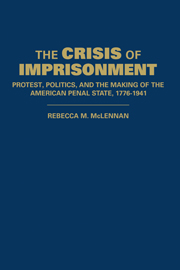Book contents
- Frontmatter
- Contents
- Acknowledgments
- Introduction: The Grounds of Legal Punishment
- 1 Strains of Servitude: Legal Punishment in the Early Republic
- 2 Due Convictions: Contractual Penal Servitude and Its Discontents, 1818–1865
- 3 Commerce upon the Throne: The Business of Imprisonment in Gilded Age America
- 4 Disciplining the State, Civilizing the Market: The Campaign to Abolish Contract Prison Labor
- 5 A Model Servitude: Prison Reform in the Early Progressive Era
- 6 Uses of the State: The Dialectics of Penal Reform in Early Progressive New York
- 7 American Bastille: Sing Sing and the Political Crisis of Imprisonment
- 8 Changing the Subject: The Metamorphosis of Prison Reform in the High Progressive Era
- 9 Laboratory of Social Justice: The New Penologists at Sing Sing, 1915–1917
- 10 Punishment without Labor: Toward the Modern Penal State
- Conclusion: On the Crises of Imprisonment
- Select Bibliography
- Index
6 - Uses of the State: The Dialectics of Penal Reform in Early Progressive New York
Published online by Cambridge University Press: 18 August 2009
- Frontmatter
- Contents
- Acknowledgments
- Introduction: The Grounds of Legal Punishment
- 1 Strains of Servitude: Legal Punishment in the Early Republic
- 2 Due Convictions: Contractual Penal Servitude and Its Discontents, 1818–1865
- 3 Commerce upon the Throne: The Business of Imprisonment in Gilded Age America
- 4 Disciplining the State, Civilizing the Market: The Campaign to Abolish Contract Prison Labor
- 5 A Model Servitude: Prison Reform in the Early Progressive Era
- 6 Uses of the State: The Dialectics of Penal Reform in Early Progressive New York
- 7 American Bastille: Sing Sing and the Political Crisis of Imprisonment
- 8 Changing the Subject: The Metamorphosis of Prison Reform in the High Progressive Era
- 9 Laboratory of Social Justice: The New Penologists at Sing Sing, 1915–1917
- 10 Punishment without Labor: Toward the Modern Penal State
- Conclusion: On the Crises of Imprisonment
- Select Bibliography
- Index
Summary
Reform is on the wing, and those in highest authority will undoubtedly see to it that small, inefficient men will be eliminated from the state's service … thereby giving the wards of the state all the opportunity for reform.
Sing Sing Convict, No. 1500, Editor, Star of Hope (1899)While it has been the convention among historians to use the term “prison reformers” to describe the loose coalition of penologists, social philanthropists, and administrators who undertook the reconstruction of imprisonment in most Northern states between 1896 and 1919, it is more accurate to say that the prisons were reformed as much by convicts, guards, wardens, labor organizers, manufacturers, workingmen, and political leaders as by these so-called reformers. Indeed, along with the usual penologists and prison administrators, these people were the coauthors of the rituals, rules, and routines of the modern American prison. Just like Benjamin Rush, Thomas Eddy, and others who, a century earlier, had met with considerable resistance in their endeavors to realize the strange new punishment of confinement to hard labor, the administrators who undertook to reinvent prisons along state-use lines in the early Progressive Era (c. 1896–1913) encountered stiff criticism and persistent attempts to subvert or modify their reform measures, both within and beyond the prison walls. Inside the prison, the efforts of administrators to erect a new order upon the ruins of the old sparked fresh forms of resistance and a series of confrontations among convicts, guards, wardens, and administrators over the appropriate means and ends of the new penal order.
- Type
- Chapter
- Information
- The Crisis of ImprisonmentProtest, Politics, and the Making of the American Penal State, 1776–1941, pp. 239 - 279Publisher: Cambridge University PressPrint publication year: 2008



